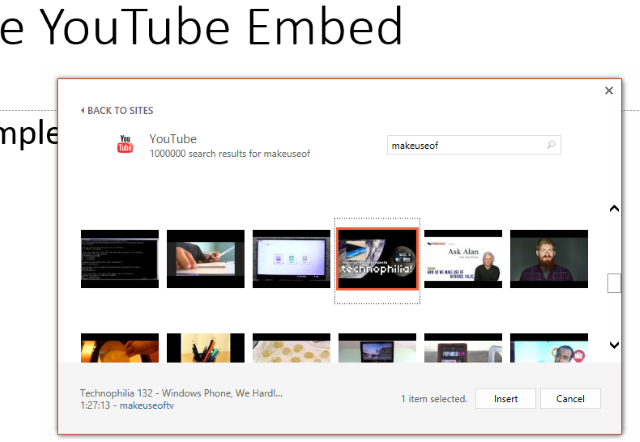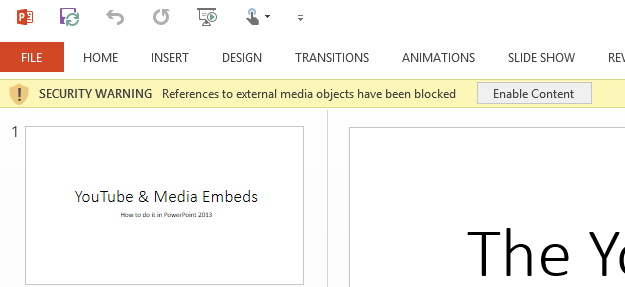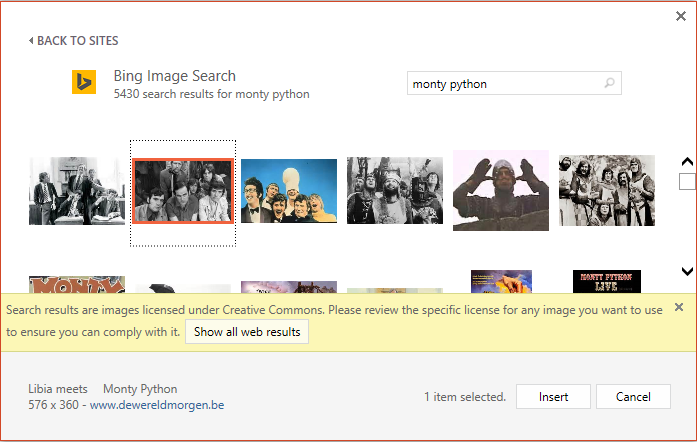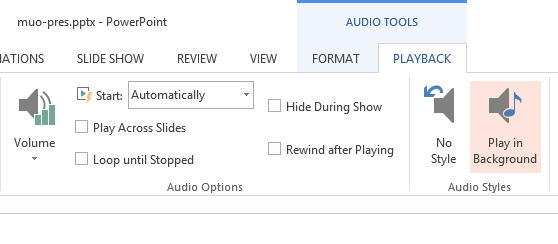Typical presentations are dull affairs with text and corporate backgrounds providing little of interest. Microsoft knows this. They even released their own PowerPoint alternative called Sway.
Nevertheless, they have been improving the media embed options of PowerPoint over the past few releases. With PowerPoint 2013/Office 365 the ability to embed online media has given the software a particular lease of life, enabling you to embed YouTube videos into PowerPoint slides.
Why Embed Media in Your PowerPoint Presentation?
In the 21st century, presentations need embedded media. It would be nice to say that time has passed on Death by PowerPoint, but this isn't strictly true. One way in which it might be discouraged, however, is by the addition of YouTube and other media embeds.
At first, it was possible to add images to your presentations; later, sound and quirky transitions. Now, it is possible to embed videos and images stored on your computer and online. Specifically, YouTube videos, those on your Microsoft OneDrive, anything stored on your local computer or network and even embed codes from other online video services can be embedded in a PowerPoint slide.
By bringing in rich media from the web, a whole new dynamic for presentations is enabled. Showing your presentation becomes a far more engaging experience, so while our 5 key tips to overhaul your presentation skills overnight advises against videos, it might be considered that you spend time finding the perfect video to embed, rather than any old clip.
YouTube Video Support in PowerPoint
YouTube video support in PowerPoint is not a new feature. However, it has been newly reintroduced after the functionality was broken in PowerPoint 2010. This occurred following a change to the video site's embed code format (discarding the old code), resulting in the video embed feature in PowerPoint being broken.
It is expected that regular updates to Office 2013/365 will result in the functionality being maintained, and this has been the case so far.
Currently, YouTube videos can be embedded in the 2013 release of PowerPoint and viewed in the 2010 and 2013 versions.
Embedding YouTube Videos in Presentations
Grabbing your audience's attention with a YouTube video will bring a whole new dimension to your presentation.
To make this happen, ready your slide with the heading and any other content you want to include, then Insert > Video > Online Video… > YouTube. This will enable you to search YouTube and embed the resulting preferred search result into your presentation, positioning it upon the slide as required.
When you're happy with the position, right-click the video and use the Start option to determine whether the clip should play automatically (when the slide loads) or on click (when clicked with a mouse). You'll also see that there are various Style options, but these don't apply to the video, only the preview image.
As you preview/view the slide, the computer you're playing it on will need to be online for the clip to be played, otherwise only a preview will be seen. You'll also need to wait a moment for the slide to load properly before clicking Play on the slide.
Note that you may need to click the Enable Content button on the Security Warning bar, depending upon your settings for PowerPoint before playback. When this happens, you'll have the option of making the file a Trusted Document.
Other Videos
Video files from your computer, local network drive, NAS or OneDrive can be added using the same menu (PowerPoint has support for AVI, MP4, MOV, MPG, SWF, WMV and ASF), as can online videos from other sources. However, PowerPoint doesn't work too well with some embed codes. For instance, it isn't possible to embed Vimeo clips in PowerPoint, even with the service's old embed code.
Adding Images From the Web
It's easy enough to add an image from your computer to a PowerPoint presentation (Insert > Pictures, or select the appropriate button on the blank slide), but what about images from the web?
Images can be found online at Office.com, OneDrive, Bing images and even Facebook and Flickr if you have those accounts associated with Office.
Open Insert > Online Pictures and browse the chosen method, using the Bing and Office.com Clip Art search tools if necessary. When the image is selected it will be copied to your presentation where you can reposition and resize as needed.
Screenshots & Photo Albums
You are probably aware of the Insert Pictures option; after all, it's been a key aspect of slide creation in PowerPoint for some years now!
But are you aware of the Insert menu's Screenshot and Photo Album options? The former enables you to insert any images that you have recently saved with Windows' Print Screen option, while the latter enables you to create and embed a picture album in a brand new slideshow, i.e. it cannot be embedded in your existing presentation. This is just one of several ways you can use PowerPoint beyond the standard presentation.
Enhance Your PowerPoint Presentation With Sound
Something else that gives your presentations an added veneer of quality is sound.
The only current online option – via Insert > Audio > Online Audio – is to insert clip audio from Office.com. Do this by searching for the sound you want to include, and then selecting from the results. Unfortunately, there is no way to preview the audio, but as the files aren't that large, this shouldn't be a problem.
Insert Local Audio
Likewise, locally stored audio can be added to presentations, as has been the case since PowerPoint 97. This is done via Insert > Audio > Audio on My PC. Various sound files from MP3 to WAV can be embedded, but for the best results these should be as small as possible so as to avoid playback having a detrimental impact on your presentation. You can also use the Record Audio option to create an audio narration for the presentation within PowerPoint.
Whichever audio option you've chosen, you can play audio across multiple slides with a single embed. After adding the media, look for the contextual Audio Tools tabs, and select Playback. Here, as well as tools to trim and add fade in and fade out, you'll find the Play in Background option. Click this and enable the Start Automatically setting. Note that the audio will overlap with other clips you include, so use this feature with care.
Enrich Your Presentations With Media Files
Virtually any media (even web pages!) can be embedded into a PowerPoint presentation, enabling you to convey ideas and concepts in increasingly interesting ways. Just make sure you honor the copyright law when using images & other media for your presenations.
Do you think there's something we missed here? Have you encountered problems with media embed in PowerPoint 2013 or Office 365? Let us know!





